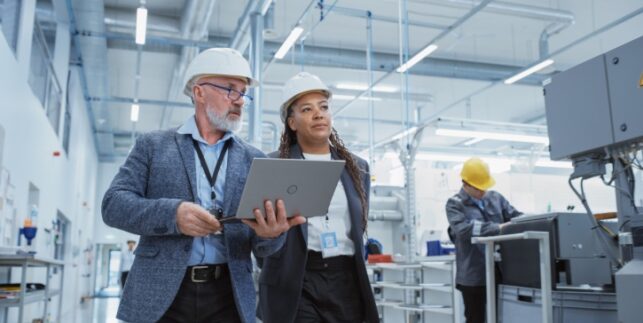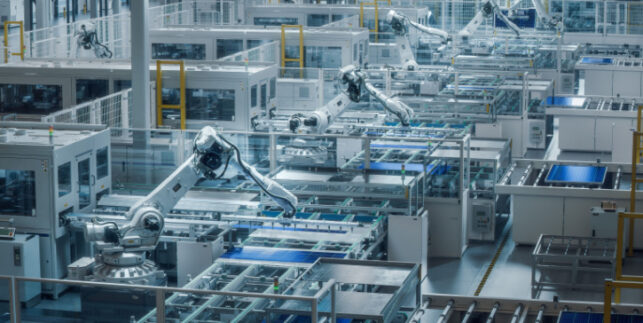A Complete Overview of the Manufacturing Sector in 2023

The manufacturing sector accounts for roughly 16 percent of the global GDP. It’s a vital industry that provides the value-added goods we rely on daily. In many countries, it serves as the backbone of the economy. The industry is constantly changing as new challenges and opportunities emerge.
Today, the manufacturing sector sits at a crossroads. The impact of the COVID-19 pandemic, supply chain challenges, and labor shortages has resulted in contraction where growth was expected. Data from the United Nations highlights a drop in manufacturing global GDP share from 16.6 percent to 16.0 percent from 2019 to 2020.
Despite these challenges, the industry maintains a positive look for the future. Governments worldwide have realized how critical these issues have become and have implemented significant legislation and policy changes to counteract decline and foster growth.
The onset and adoption of Industry 4.0 technologies are creating new opportunities within the industry. New production methods and advanced manufacturing solutions enable manufacturers to face supply chain and labor shortage challenges while meeting new heights of sustainability and waste reduction, employing new technologies to improve overall manufacturing efficiencies.
Despite global setbacks, the manufacturing sector is ready to rebound and enter a more productive, resilient, and sustainable future.
The Current State of the Manufacturing Sector
Both recovery and ongoing challenges mark the current state of the manufacturing sector. Recovery following the height of the COVID-19 pandemic has made a significant impact, but the industry still struggles with supply chain and labor shortages. However, manufacturers are also implementing productivity solutions to face those challenges.
Reduced Productivity Driven by Labor Shortages
The COVID-19 pandemic and other factors resulted in the onset of both labor and supply chain shortages. While the manufacturing sector has been able to react and mitigate these challenges in many ways, there is still an ongoing impact.
The latest report from the US Department of Labor highlights the difficulties the manufacturing sector has faced over the past several years, gradual recovery, and ongoing challenges.
The onset of the pandemic resulted in a 7.4 percent reduction in hours worked and a 6.6 percent reduction in output in 2020. The industry saw significant recovery across 2021 and 2022, with increases in hours worked of 3.1 and 4.2 percent, respectively.
Despite this recovery, the third and fourth quarters of 2022 saw output declines. While 2022 saw an increase in overall output annually, labor productivity dropped as the number of hours worked increased more steeply.
The industry has shown significant recovery, but the ongoing labor shortage and other factors have led to faltering that many manufacturers may struggle to manage.
Supply Chain Shortages on the Mend
The impact of the COVID-19 pandemic hit the manufacturing industry hard as global supply chains rapidly began to show signs of stress. Lead times and pricing for certain materials increased significantly. The severity of lockdowns in China, the world’s largest manufacturer, had a global supply chain impact.
Today, shortages in many vital areas have lessened considerably. Data from the January 2023 Logistics Manager’s Index Report shows that supply chain growth is increasing at an accumulative rate, showing significant recovery.
The addition of 517,000 jobs to the US economy in January, including 23,000 in transportation and warehousing, bodes well for supply chains. Increases in warehousing and transportation capacity and utilization also point to healthy supply chains.
As the immediate pressure begins to fade, many manufacturers are looking for solutions to improve the resiliency of their supply chains against future challenges.
Advanced Manufacturing Adoption
Many manufacturers are already seeing success in implementing advanced manufacturing technology. A study by McKinsey evaluated advanced industry lighthouses (companies using Industry 4.0 technologies at scale) and identified high-impact use cases held in common across those organizations.
Flexible automation delivered a high impact in 68 percent of those organizations. This use case involves more sophisticated automation that can adapt as process conditions and targets change. They optimize production flow in reaction to real-time data, delivering improved performance and efficiency.
Another 46 percent achieve a high impact through digital performance management. Real-time aggregation and production data analysis enable manufacturers to make better decisions and improve performance. Greater accuracy and visibility help bolster production even further.
In 38 percent of organizations, quality analytics appeared as an impactful advanced manufacturing technology. Using new solutions to monitor and analyze quality enabled more effective root cause analysis and faster reactions to process upsets.
Advanced analytics-based process control delivered a high impact for 32 percent of organizations. AI, ML, and other novel analysis methods enable predictive controls based on production data, improving productivity and avoiding production issues.
These solutions are seeing wide adoption among industry leaders. However, many other technologies promise benefits as well. Dynamic scheduling, energy management, and digital twins are all exciting new solutions that will contribute to the future of manufacturing.
Where the Manufacturing Sector Is Headed
While the industry has successfully navigated many challenges over the past several years, it may still have more to come. The labor shortage presents a persistent obstacle that may worsen over the coming years. However, new opportunities and initiatives also bode well for implementing new advanced manufacturing technologies and developing a more robust workforce.
Potential Workforce Challenges Ahead
While supply chain challenges are beginning to improve, manufacturers could still face significant difficulty maintaining a skilled workforce for the foreseeable future. A study by Deloitte puts net job loss in the manufacturing sector during the peak of the pandemic at 578,000. However, open positions in the industry have hovered consistently around 500,000.
That study estimates an expected 2.1 million unfilled jobs in the US manufacturing sector by 2030. A significant skills gap drives the widening labor deficit. The existing workforce lacks the specific technical skills and training that the modern manufacturing sector demands.
The study surveyed manufacturers throughout the industry and found that 77 percent anticipate ongoing difficulties in retaining and attracting new employees. Manufacturers are facing challenges in filling both entry-level and senior positions.
Despite already above-average wages in the industry increasing over the past several years, manufacturers struggle to attract entry-level employees. Jobs that require specialized skills are even more challenging to fill, as there is a significant deficit in experienced and trained candidates.
Anticipated growth and retirements from the industry are expected to leave 4 million manufacturing jobs in need of filling between 2020 and 2030. Less than half are expected to be filled, with 2.1 million remaining vacant due to the skill gap and other factors related to the labor shortage.
Efforts to Develop a Skilled Manufacturing Workforce
While manufacturers face considerable challenges in dealing with the ongoing labor shortage, efforts are underway to revitalize the workforce and prevent such a substantial deficit. Much of that drive comes from manufacturers themselves, who are finding new ways to make the best possible use of their existing workforce.
Upskilling is one of the most significant trends, with manufacturers investing the time and money necessary to develop existing employees. In order to fill the skills gap, manufacturers are training employees for new roles and to handle the new technologies they’re implementing on the factory floor.
Such an approach serves to fill immediate openings in crucial roles. It also provides a vital tool for attracting new talent. A Deloitte survey shows that 80% of respondents showed more interest in manufacturing positions when those positions offered the prospect of enhanced training and clear career paths.
The US Government has also taken notice of the developing skills gap and adopted a variety of measures to mitigate its effects. The CHIPS and Science Act directs $280 billion in spending toward R&D and workforce development in semiconductors and other tech manufacturing. That includes developing the education and training resources needed to helm a revitalized US semiconductor industry.
The National Strategy for Advanced Manufacturing will provide further skilled workforce development over the coming years. One of the primary goals of the strategy is to grow the advanced manufacturing workforce alongside developing and implanting advanced manufacturing technologies and resilient supply chains.
Efforts will include promoting awareness of advanced manufacturing careers and incorporating advanced manufacturing into foundational STEM education. Expanding work-based learning and apprenticeships is another key target, along with establishing industry-recognized technologies and practices.
The manufacturing sector has significant challenges to overcome in the next few years to eliminate the skills gap. However, both the industry and the government are taking action to that end.
Revitalizing US Manufacturing Through Reshoring
The US was once the world’s largest manufacturer. However, China overtook the US in terms of manufacturing output in 2010. China now accounts for 28.7 percent of global manufacturing, while the US sits in second place with 16.8 percent.
The rise of offshore competition led to the production of an ever-increasing percentage of value-added goods outside of the US, but a new trend is starting to see that change. However, Reshoring has now become a significant trend in the industry, driven by the need to build more resilient supply chains and ensure sustainable manufacturing.
Reshoring was already taking place before the onset of the COVID-19 pandemic, as the US added 1.3 million manufacturing jobs between 2010 and 2019. The period from 2000 to 2009 saw a loss of 5.8 million jobs, so this new trend marked a significant reversal.
Data from the Reshoring Initiative shows that US job development has outpaced foreign direct investment for three years running as of the end of 2022. Government incentives, workforce availability, and supply chain risk are the most prominent trends driving this growth.
As more companies shift supply chains stateside, the demand for US manufacturing output will only increase. While promising for the industry, this trend may put even more pressure on an already strained workforce.
Developing New Skills for an Advanced Manufacturing Workforce
As manufacturers continue to adopt advanced manufacturing technologies, the balance of critical skills needed in the workforce will shift as well. The manufacturing sector needs a workforce with the skills required to implement and use the latest technologies. These skills cover a wide range of categories across different roles within manufacturing operations.
In terms of product and process design, the industry is shifting toward design for manufacturing. This principle focuses on optimizing the manufacturing process as a primary goal of the design process rather than starting with the product design and working backward.
Project lifecycle management is another design principle key to the future of manufacturing. Integrating all parts of the life cycle, from raw material procurement to final disposal, aims to improve both efficiency and sustainability.
On the factory floor, the trend is toward operators and technicians capable of working with the latest advanced manufacturing solutions. A focus on operations technology infrastructure and AI and ML technologies is changing the role of production teams on the factory floor. Manufacturers need a workforce prepared to handle these new solutions.
Realizing such a workforce requires a new approach to education and training. A survey of industry thought leaders by Autodesk revealed that83% believe that a more direct connection between industry and education is vital to building this future manufacturing workforce.
How Industry 4.0 Stands to Change the Manufacturing Sector
With both challenges and opportunities on the horizon, the manufacturing sector requires new solutions to continue growth into the future. Industry 4.0 already provides many such solutions, with more on the way as technology continues to advance.
Automation, AI, ML, IoT, cloud connectivity, and other technologies make today’s factories more efficient and productive. While future factories may see entirely new production methods and technologies, manufacturers need solutions that improve existing facilities today.
Industry 4.0 technologies that are available today can have a significant impact on any manufacturing operation. They can provide the capabilities manufacturers need to overcome the supply chain and labor shortage challenges they continue to face.
Reducing Labor Requirements
Automation has reached new heights in modern manufacturing, with nearly 3.5 million industrial robots operating in factories around the world, according to the International Federation of Robotics. However, this is far from the only way that Industry 4.0 technologies are reducing labor requirements.
A more subtle type of automation focuses on the collection and handling of production data. Both new and conventional sensors can now be integrated into centralized solutions through IoT technology. The same goes for machines of any type, even legacy machines with no built-in connectivity features.
With all production data captured in real-time, manufacturers eliminate the need for manual data collection or even time spent navigating between disparate applications and solutions. Production teams now have access to all production data through the automated collection, along with analytics and further insights.
Giving Employees the Right Tools
A crucial part of dealing with the labor shortage is ensuring that the existing workforce has the necessary tools to maximize productivity and efficiency. Human-machine interaction is now a central area of focus in Industry 4.0, developing solutions that augment employee capabilities rather than replacing them.
Features such as real-time production monitoring and work management tools provide both visibility and control for production teams. A system that consolidates all aspects of production lets production team members make effective decisions within the context of production as a whole.
Advanced manufacturing technologies stand to empower production teams even further. The use of AI and ML can uncover even greater insights for production teams. Using tools like statistical process control, production teams can be made aware of process issues before they happen and act to prevent them.
Attracting Skilled Candidates
Industry 4.0 technologies also serve to make manufacturers more attractive as employers for skilled candidates. Among the most prominent means to do so is by making more flexible remote and hybrid work opportunities possible.
A Deloitte survey found that 36 percent of US workers put flexibility in work location and schedule as one of their top priorities, a value that rises to 63 percent in the 18 to 24-year-old age group. Conventional manufacturing provides little flexibility, but Industry 4.0 technology can change that.
While some roles are limited in their capacity for remote or hybrid work, increased visibility and connectivity make them possible in as many roles as possible. Consolidating production data and controls into a single platform with secure cloud access makes many tasks possible from anywhere, along with allowing for greater inter-facility cooperation.
Facing Challenges and Seizing Opportunity With Matics
Manufacturers today face unique challenges to those they have already overcome in the past. Facing supply chain and labor shortages may be possible with the right Industry 4.0 solutions, but implementing those solutions on your factory floor presents a challenge in itself.
Matics Real-time Operational Intelligence (RtOI) provides a comprehensive solution that works seamlessly with your existing systems, machines, and other resources. Gain real-time visibility into your production, empower production teams with work management tools, and leverage advanced features such as statistical process control.
Matics can implement RtOI to suit your existing manufacturing operations without disruption or downtime. You can enjoy a smooth transition to improved productivity and efficiency on your factory floor. Book your demo today to find out more about all of our solution’s features.




